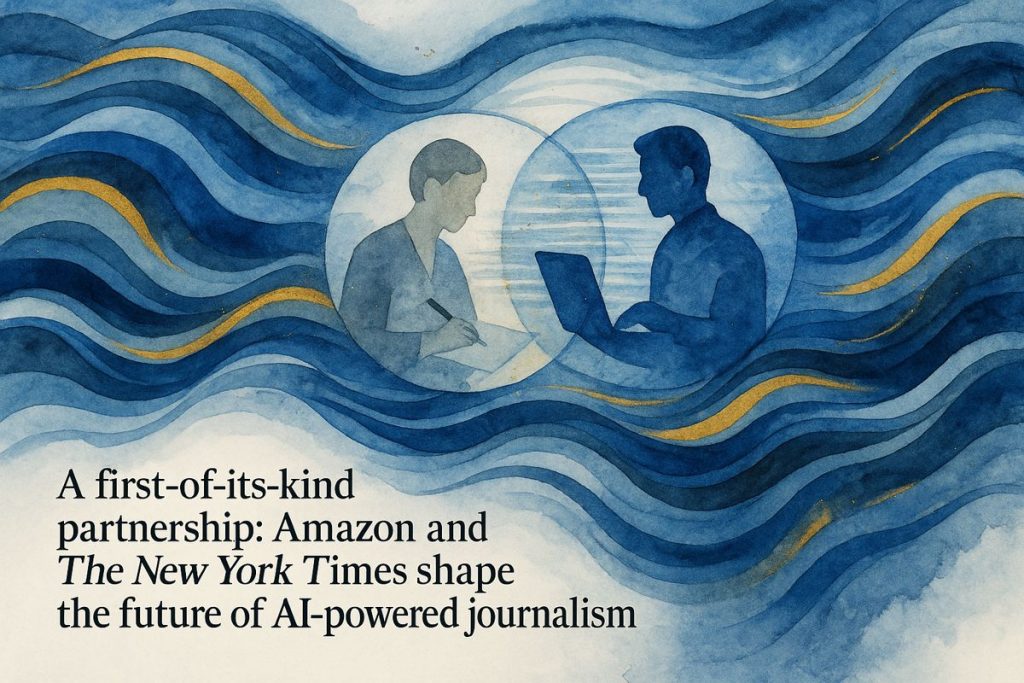Amazon and The New York Times have teamed up in a big new deal, letting Alexa use real Times news, stories, and features for smart voice updates. Alexa will now serve up fresh, trustworthy headlines and even link you straight to the Times’ own apps, making news feel more real and reliable. This partnership is happening because good news is rare and valuable—so both sides hope to win: Amazon gets quality, the Times gets paid and stays in control. But there’s a worry that quick voice summaries might stop people from visiting the Times’ website, risking lost readers and money. In the background, everyone’s scrambling to protect rights, prevent copycats, and keep up as AI changes news faster than anyone expected.
What is the Amazon and New York Times AI content licensing deal?
The Amazon and New York Times AI content licensing deal is a multi-year agreement allowing Amazon to use NYT content—such as news articles, opinions, and features—to enhance Alexa’s real-time news updates. This partnership aims to provide users with trusted, high-quality journalism through voice assistant technology.
The Dawn of a New (Algorithmic) Age
So, Amazon and The New York Times have finally done what many suspected was percolating in the background—signed a multi-year AI content licensing deal. Think of it as a handshake inked in silicon and syllables rather than newsprint and ink. If you’d told me even five years ago that two stalwarts—Amazon, king of cloud and commerce, and the Times, guardian of Gray Lady journalism—would merge their destinies in the hyperspectral glare of generative AI, I might’ve spilled my coffee. Or at least raised an eyebrow.
The agreement means Amazon gains a veritable palimpsest of NYT content: bracing headlines, piquant op-eds, the umami of NYT Cooking, and the athletic verve of The Athletic (that 2022 acquisition finally flexes its muscles). But not Wirecutter—Amazon’s keeping its digital mitts off that one, as pre-existing commercial arrangements render it off-limits. That detail, by the way, reveals the nuanced dance of rights and revenue streams behind the glossy press release. Don’t blink, or you’ll miss the legalese.
I had to stop and ask myself: Who benefits most? The answer, squinting through the aromatic haze of espresso, is both and neither—depending on whether you’re measuring by dollars, data, or sheer narrative control.
Machines That Smell News
Let’s get concrete. Amazon isn’t just stuffing NYT stories into a digital vault. Instead, it’ll lace Alexa with fresh, trusted news—no more “according to unspecified sources” when you ask for today’s headlines. Real-time answers, direct links back to NYT apps, and transparent attributions will start to feel as intuitive as the purr of a well-oiled espresso machine.
You might imagine Alexa’s voice, once monotone and synthetic, now seasoned with the gravitas of Pulitzer-winning prose. Will it ever achieve the timbre of a grizzled anchor or the zing of a morning paper? Maybe not. But if you listen closely—between the electric hums and digital chirps—there’s a whiff of journalistic authority, as if the New York Times newsroom itself has been distilled into code.
It’s a two-way street. The Times, historically as guarded as a Fabergé egg when it comes to intellectual property, is stepping into the AI training arena for the first time. This isn’t just about licensing; it’s about laying down markers. Rights must be respected. Compensation must be tangible. In an era where GPT models can churn out facsimiles of the news faster than you can say “Hallucination,” protecting the editorial DNA is existential.
There’s a certain trepidation here—one I recognize from a past project where our API got cannibalized by a third-party aggregator. At first, I was incensed; then I realized it was a lesson in digital resilience. Ugh, the learning curve.
The Economics of Trust and the Litigation Zeitgeist
Pause for a moment. Why is all this happening now? Simple: high-quality news content is the rare earth mineral of the AI epoch. Generative AI is voracious, gobbling up terabytes of raw data, but most of it is digital dross—echo chambers, shallow takes, ephemeral trends. When a system ingests the New York Times, it’s like swapping fast food for a tasting menu curated by Michelin-starred editors.
Industry-wide, the NYT-Amazon deal is a canary in the coalmine (or maybe a Cassandra, muttering warnings no one wants to hear). Other publishers—The Guardian, NewsCorp, Axel Springer—have inked similar deals with OpenAI and Google (see Press Gazette coverage), trying to monetize their archives before algorithms make them obsolete. Yet, at the same time, legal storms gather. The Times is actively suing OpenAI and Microsoft for alleged unauthorized content scraping. It’s a legal palimpsest: new rules penned over old disputes, with “fair use” smeared like coffee stains across both sides of the argument.
At this point, I’ll admit: I once underestimated the velocity of these tectonic shifts. Last March, I predicted these deals would take years to materialize. Bam!—three months later, the landscape had changed.
Summaries, Subscriptions, and the Battle for Eyeballs
Here’s the rub: as Alexa becomes your morning news sommelier, will you actually visit the Times’ website? There’s a faint, metallic tang of risk here—summaries and snippets may whet appetites but cannibalize full-course meals. Publishers fret about audience “leakage” and the erosion of subscription revenue, with every AI voiceover a potential lost click.
And yet, there’s resilience. The industry is experimenting with watermarking, digital fingerprinting, and even deploying AI watchdogs to sniff out illicit reuse (TechCrunch analysis). Meanwhile, regulatory bodies from Brussels to Canberra are itching to draft frameworks that ensure tech giants don’t subsume the entire informational biosphere (ACCC commissioned report)
